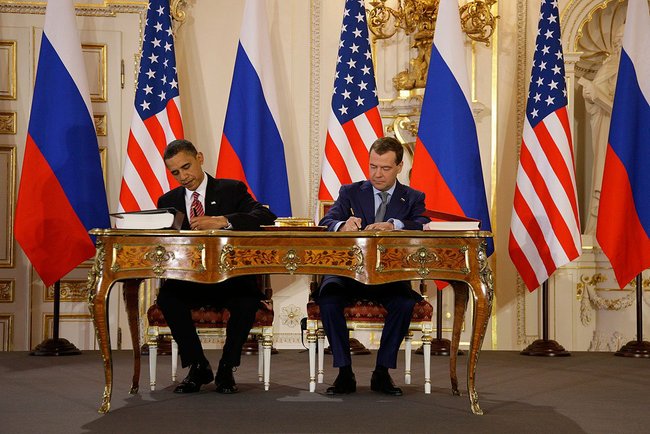
This past month, President Obama put forth America’s new global nuclear nonproliferation and disarmament strategy in Berlin. In his remarks, the President included proposals for various initiatives including a new bilateral nuclear stockpile reduction plan with Russia, a pledge to initiate new treaties banning fissile material production, support of the Comprehensive Test Ban Treaty, and the usual commitments to contain Iran and North Korea (Obama 2013). While these initiatives are productive for moving towards a nuclear-free world and containing short-term threats, the Administration’s new nuclear strategy fails to sufficiently address two pressing issues that represent great threats to long-term U.S. national and global security interests: the nuclear standoff between Pakistan and India, and the tactful development of China’s nuclear arsenal. It appears the U.S. is still operating in an immediate post-Cold War mindset where bilateral reductions between Russia and the U.S. remain the central theme of U.S. nuclear policy. However, if the U.S. is to ensure long-term global security, it should stop focusing on Russia and instead make Pakistan, India, and China top long-term priorities of global nonproliferation and disarmament efforts.
Negotiated bilateral reductions with Russia should no longer be the core of U.S. disarmament efforts. While the U.S. and Russia still maintain the greatest number of nuclear warheads- 7,700 and 8,500 total inventory, respectively- both sides have established command and control structures including advanced warning systems, vastly improved safeguards to prevent theft by transnational actors, and an established communication hotline to ameliorate any potential misunderstandings (Center for Arms Control and Non-Proliferation 2013). The former nemeses have learned valuable lessons from the Cold War and no longer represent a great threat to global security, especially as each state continues on a successful 20-year reduction in nuclear arms. The U.S. should instead direct its attention towards two countries that are engaged in a situation that may be much more dangerous than that of the Cold War: Pakistan and India.
Unlike the U.S. and Russia, both Pakistan and India are increasing the number of tactical nuclear weapons and lack the aforementioned communication and warning measures (Stockholm International Peace Research Institute 2013). Pair these alarming developments with Pakistan and India’s tumultuous history and a shared border, and the world has a serious threat of nuclear conflict. Indeed, a border skirmish or misinterpreted military training exercise could very well escalate to a nuclear conflict. In addition to the more traditional threat of nuclear war, Pakistan represents a dire nuclear proliferation threat. Some experts have asserted that Pakistan is the most dangerous country in the world due to the possibility of transnational actors gaining access to its nuclear material (Cirincione 2012). Indeed, the Nuclear Threat Initiative ranks Pakistan 31/32 out of countries that possess weapons-usable nuclear material in terms of nuclear materials security (Nuclear Threat Initiative 2012). India lacks sufficient safeguards as well and therefore has received a poor rating of 28/32 (Nuclear Threat Initiative 2012). The U.S. should be making this potential hot zone a top priority of its nuclear nonproliferation and disarmament policy, not the Kremlin’s more secure, declining nuclear arsenal.
As Russia and the U.S. work towards decreasing their nuclear stockpiles, China is the only one of the five original nuclear weapons states that is increasing its nuclear arsenal (Kristensen and Norris 2011). Expert assessments of the number of Chinese nuclear warheads vary dramatically due to the opaque nature of China’s nuclear program. While the majority of experts agree that China maintains at least 250-300 nuclear warheads (Center for Arms Control and Nonproliferation 2013), other reports indicates China maintains as many as 3,000 nuclear warheads (Wan 2011). China is also estimated to have produced enough plutonium and highly-enriched uranium for up to 1,660 warheads (Kristensen 2011). These estimates should be very alarming, but China’s growing arsenal is often under-addressed in public U.S. nuclear policy circles. Why? Certainly the entrenched economic relationship is a deterring factor from addressing China directly, but this should not prevent the U.S. from engaging China bilaterally and multilaterally on this issue. China is a party to the Nuclear Nonproliferation Treaty (NPT) and can be easily brought into the disarmament conversation. Pakistan and India represent a greater challenge since they are not part of the NPT, but both countries could be included in the international nonproliferation regime through other less restrictive bodies, such as the Nuclear Suppliers Group, for further engagement aimed at encouraging peaceful development of their respective civilian nuclear programs in exchange for reductions in nuclear warheads.
Current U.S. nuclear nonproliferation and disarmament efforts are ineffective at addressing long-term nuclear concerns. The U.S. Government is taking positive steps by hosting international forums such as the Nuclear Summit every 5 years, but these chat shops are not enough. The situation between Pakistan and India demands immediate attention and China needs to be called out on its growing nuclear weapons arsenal. As part of its overall nuclear strategy, the U.S. needs to make a central shift away from Russia in order to bilaterally and multilaterally engage China, India, and Pakistan. This pivot will be tricky because of competing U.S. strategic interests in Asia, and because India and Pakistan are not members of many established nonproliferation treaties and agreements. However, the U.S. should recognize that its long-term security interests necessitate inoculating these problems in their early stages rather than waiting for a nuclear disaster in South Asia or the emergence of an even more heavily-armed China.
The author would like to thank Bradlee McAuliffe and Matthew Woo for their contributions to this piece.






